Supervised Machine Learning to Predict Drilling Temperature of Bone
Abstract
:1. Introduction
- To investigate the crucial machinability factors affecting the bone drilling process, with a particular emphasis on the temperature distribution. By exploring the thermo-mechanical properties of these factors, we aim to enhance our understanding and improve the efficiency of bone drilling procedures.
- To evaluate the performance of bovine bone under varying machining conditions, specifically focusing on the effects of the spindle speed, feed rate, and drill bit diameter. Additionally, we seek to analyze the thermo-mechanical interactions occurring during the drilling process.
- To enhance the machining parameters and determine the best combinations of the spindle speed, feed rate, and drill bit diameter to reduce thermal osteonecrosis in bone by utilizing the Response Surface Methodology (RSM).
- To deploy ML models, particularly random forest (RF) and support vector machine (SVM), to forecast the highest temperature increase. To assess the model’s accuracy and performance in predicting the machining results based on the input variables and confirm the precision and dependability of the ML models.
2. Materials and Methods
2.1. Response Surface Methodology
2.2. Support Vector Machine for Regression (SVR)
2.3. Random Forest Regression (RFR)
2.4. Data Pre-Processing and Performance Evaluation Metrics
3. Results and Discussion
3.1. Optimization Using RSM
3.2. Prediction of Response Variables by SVM and RF
3.3. Comparison of Machine Learning and RSM Models
4. Conclusions
- The RSM method found that the best operating conditions were achieved with a tool diameter of 2 mm, a feed rate of 40 mm/min, and a spindle speed of 1000 rpm.
- This study found that the RFR model outperformed the SVM regression model and RSM, as evidenced by the lower errors in the performance metrics when comparing the three methods.
- The precision in predicting the bone drilling temperatures using the RSM method is 79%, while it is 97.3% with RFR and 25.7% with SVR models.
- The machine learning RFR model enhanced the drilling efficiency and reduced the risk of bone thermal damage by accurately predicting the temperature rises.
4.1. Significance of the Study
4.2. Limitations
Author Contributions
Funding
Institutional Review Board Statement
Informed Consent Statement
Data Availability Statement
Acknowledgments
Conflicts of Interest
References
- Pupulin, F.; Oresta, G.; Sunar, T.; Parenti, P. On the thermal impact during drilling operations in guided dental surgery: An experimental and numerical investigation. J. Mech. Behav. Biomed. Mater. 2024, 150, 106327. [Google Scholar] [CrossRef] [PubMed]
- Mediouni, M.; Kucklick, T.; Poncet, S.; Madiouni, R.; Abouaomar, A.; Madry, H.; Cucchiarini, M.; Chopko, B.; Vaughan, N.; Arora, M.; et al. An overview of thermal necrosis: Present and future. Curr. Med. Res. Opin. 2019, 35, 1555–1562. [Google Scholar] [CrossRef] [PubMed]
- Akhbar, M.F.A.; Yusoff, A.R. Fast & Injurious: Reducing thermal osteonecrosis regions in the drilling of human bone with multi-objective optimization. Measurement 2020, 152, 107385. [Google Scholar]
- Donos, N.; Akcali, A.; Padhye, N.; Sculean, A.; Calciolari, E. Bone regeneration in implant dentistry: Which are the factors affecting the clinical outcome? Periodontology 2000 2023, 93, 26–55. [Google Scholar] [CrossRef] [PubMed]
- Wildemann, B.; Ignatius, A.; Leung, F.; Taitsman, L.A.; Smith, R.M.; Pesántez, R.; Stoddart, M.J.; Richards, R.G.; Jupiter, J.B. Non-union bone fractures. Nat. Rev. Dis. Primers 2021, 7, 57. [Google Scholar] [CrossRef]
- Augustin, G.; Davila, S.; Mihoci, K.; Udiljak, T.; Vedrina, D.S.; Antabak, A. Thermal osteonecrosis and bone drilling parameters revisited. Arch. Orthop. Trauma Surg. 2008, 128, 71–77. [Google Scholar] [CrossRef]
- Islam, M.A.; Kamarrudin, N.S.; Daud, R.; Ibrahim, I.; Razlan, Z.M.; Rani, M.F.H. Drill Bit Design and Its Effect on Temperature Distribution and Osteonecrosis During Implant Site Preparation: An Experimental Approach. J. Phys. Conf. Ser. 2023, 2643, 012020. [Google Scholar] [CrossRef]
- Kung, P.C.; Heydari, M.; Tsou, N.T.; Tai, B.L. A neural network framework for immediate temperature prediction of surgical hand-held drilling. Comput. Methods Programs Biomed. 2023, 235, 107524. [Google Scholar] [CrossRef]
- Agarwal, R.; Singh, J.; Gupta, V. Prediction of temperature elevation in rotary ultrasonic bone drilling using machine learning models: An in-vitro experimental study. Med. Eng. Phys. 2022, 110, 103869. [Google Scholar] [CrossRef]
- Staroveski, T.; Brezak, D.; Udiljak, T. Drill wear monitoring in cortical bone drilling. Med. Eng. Phys. 2015, 37, 560–566. [Google Scholar] [CrossRef]
- Ghavami, P. Big Data Analytics Methods: Analytics Techniques in Data Mining, Deep Learning and Natural Language Processing; Walter de Gruyter GmbH & Co. KG: Berlin, Germany, 2019. [Google Scholar]
- Pandey, R.K.; Panda, S.S. Optimization of bone drilling using Taguchi methodology coupled with fuzzy based desirability function approach. J. Intell. Manuf. 2015, 26, 1121–1129. [Google Scholar] [CrossRef]
- Akgundogdu, A.; Jennane, R.; Aufort, G.; Benhamou, C.L.; Ucan, O.N. 3D image analysis and artificial intelligence for bone disease classification. J. Med. Syst. 2010, 34, 815–828. [Google Scholar] [CrossRef] [PubMed]
- Lu, C.H.; Ko, E.W.C.; Liu, L. Improving the video imaging prediction of postsurgical facial profiles with an artificial neural network. J. Dent. Sci. 2009, 4, 118–129. [Google Scholar] [CrossRef]
- Agarwal, R.; Singh, J.; Gupta, V. Predicting the compressive strength of additively manufactured PLA-based orthopedic bone screws: A machine learning framework. Polym. Compos. 2022, 43, 5663–5674. [Google Scholar] [CrossRef]
- Agarwal, R.; Singh, J.; Gupta, V. An intelligent approach to predict thermal injuries during orthopaedic bone drilling using machine learning. J. Braz. Soc. Mech. Sci. Eng. 2022, 44, 320. [Google Scholar] [CrossRef]
- Torun, Y.; Öztürk, A. A new breakthrough detection method for bone drilling in robotic orthopedic surgery with closed-loop control approach. Ann. Biomed. Eng. 2020, 48, 1218–1229. [Google Scholar] [CrossRef]
- Au, E.H.; Francis, A.; Bernier-Jean, A.; Teixeira-Pinto, A. Prediction modeling—Part 1: Regression modeling. Kidney Int. 2020, 97, 877–884. [Google Scholar] [CrossRef]
- Islam, M.A.; Kamarrudin, N.S.; Daud, R.; Ibrahim, I.; Bakar, S.A.; Noor, S.N.F.M. Quantifying the Impact of Drilling Parameters on Temperature Elevation within Bone during the Process of Implant Site Preparation. J. Adv. Res. Appl. Mech. 2024, 116, 1–12. [Google Scholar] [CrossRef]
- Islam, M.A.; Kamarrudin, N.S.; Suhaimi, M.F.F.; Daud, R.; Ibrahim, I.; Mat, F. Parametric Investigation on Different Bone Densities to Avoid Thermal Necrosis during Bone Drilling Process. J. Phys. Conf. Ser. 2021, 2051, 012033. [Google Scholar] [CrossRef]
- Akhbar, M.F.A.; Yusoff, A.R. Multi-objective optimization of surgical drill bit to minimize thermal damage in bone-drilling. Appl. Therm. Eng. 2019, 157, 113594. [Google Scholar] [CrossRef]
- Ali Akhbar, M.F.; Yusoff, A.R. Drilling of bone: Effect of drill bit geometries on thermal osteonecrosis risk regions. Proc. Inst. Mech. Eng. Part H J. Eng. Med. 2019, 233, 207–218. [Google Scholar]
- Shakouri, E.; Haghighi Hassanalideh, H.; Gholampour, S. Experimental investigation of temperature rise in bone drilling with cooling: A comparison between modes of without cooling, internal gas cooling, and external liquid cooling. Proc. Inst. Mech. Eng. Part H J. Eng. Med. 2018, 232, 45–53. [Google Scholar] [CrossRef] [PubMed]
- Hillery, M.T.; Shuaib, I. Temperature effects in the drilling of human and bovine bone. J. Mater. Process. Technol. 1999, 92, 302–308. [Google Scholar] [CrossRef]
- Sui, J.; Sugita, N. Experimental study of thrust force and torque for drilling cortical bone. Ann. Biomed. Eng. 2019, 47, 802–812. [Google Scholar] [CrossRef]
- Islam, M.A.; Kamarrudin, N.S.; Daud, R.; Mohd Noor, S.N.F.; Azmi, A.I.; Razlan, Z.M. A review of surgical bone drilling and drill bit heat generation for implantation. Metals 2022, 12, 1900. [Google Scholar] [CrossRef]
- Li, S.; Shu, L.; Kizaki, T.; Bai, W.; Terashima, M.; Sugita, N. Cortical bone drilling: A time series experimental analysis of thermal characteristics. J. Manuf. Process. 2021, 64, 606–619. [Google Scholar] [CrossRef]
- Wang, Y.; Cao, M.; Zhao, Y.; Zhou, G.; Liu, W.; Li, D. Experimental investigations on microcracks in vibrational and conventional drilling of cortical bone. J. Nanomater. 2013, 2013, 845205. [Google Scholar] [CrossRef]
- Pandithevan, P.; Pandy, N.V.M. Multi-objective optimization for surgical drilling of human femurs: A methodology for better pull-out strength of fixation using taguchi method based on membership function. J. Mech. Med. Biol. 2020, 20, 1950072. [Google Scholar] [CrossRef]
- Pandithevan, P.; Pandy, N.V.M.; Palanivel, C. Development of in-situ temperature prediction models from cadaveric human femur for bone drilling. J. Mech. Med. Biol. 2018, 18, 1850026. [Google Scholar] [CrossRef]
- Moghaddas, M.A. Modeling and optimization of thrust force, torque, and surface roughness in ultrasonic-assisted drilling using surface response methodology. Int. J. Adv. Manuf. Technol. 2021, 112, 2909–2923. [Google Scholar] [CrossRef]
- Akhbar, M.F.A.; Yusoff, A.R. Optimization of drilling parameters for thermal bone necrosis prevention. Technol. Health Care 2018, 26, 621–635. [Google Scholar] [CrossRef] [PubMed]
- Mondal, N.; Mandal, M.C.; Dey, B.; Das, S. Genetic algorithm-based drilling burr minimization using adaptive neuro-fuzzy inference system and support vector regression. Proc. Inst. Mech. Eng. Part B J. Eng. Manuf. 2020, 234, 956–968. [Google Scholar] [CrossRef]
- Song, Z.; Zhao, Y.; Liu, G.; Gao, Y.; Zhang, X.; Cao, C.; Dai, D.; Deng, Y. Surface roughness prediction and process parameter optimization of Ti-6Al-4 V by magnetic abrasive finishing. Int. J. Adv. Manuf. Technol. 2022, 122, 219–233. [Google Scholar] [CrossRef]
- Li, L.-N.; Liu, X.-F.; Yang, F.; Xu, W.-M.; Wang, J.-Y.; Shu, R. A review of artificial neural network based chemometrics applied in laser-induced breakdown spectroscopy analysis. Spectrochim. Acta Part B At. Spectrosc. 2021, 180, 106183. [Google Scholar] [CrossRef]
- Ein-Afshar, M.J.; Shahrezaee, M.; Shahrezaee, M.H.; Sharifzadeh, S.R. Biomechanical evaluation of temperature rising and applied force in controlled cortical bone drilling: An animal in vitro study. Arch. Bone Jt. Surg. 2020, 8, 605. [Google Scholar]
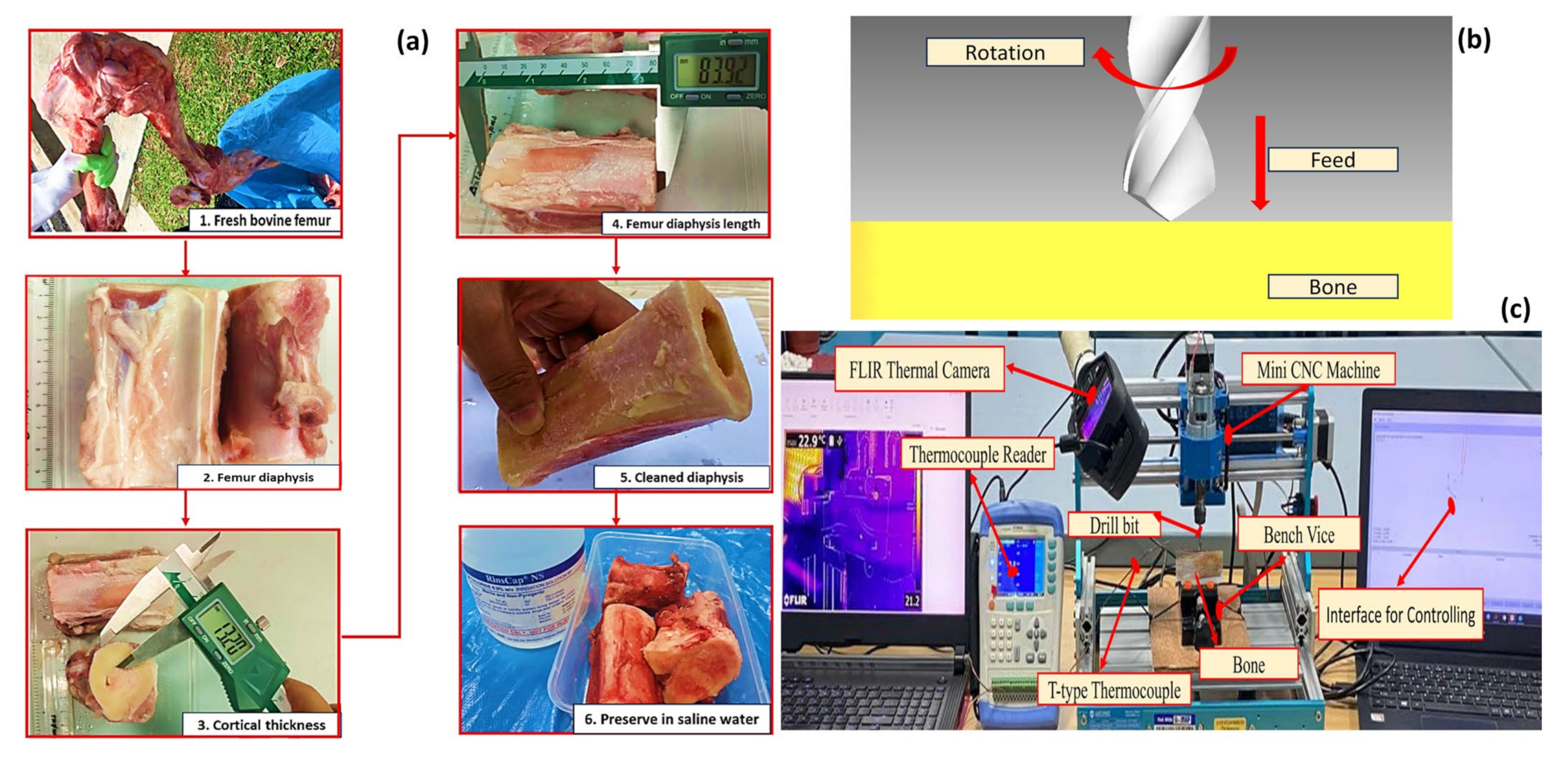
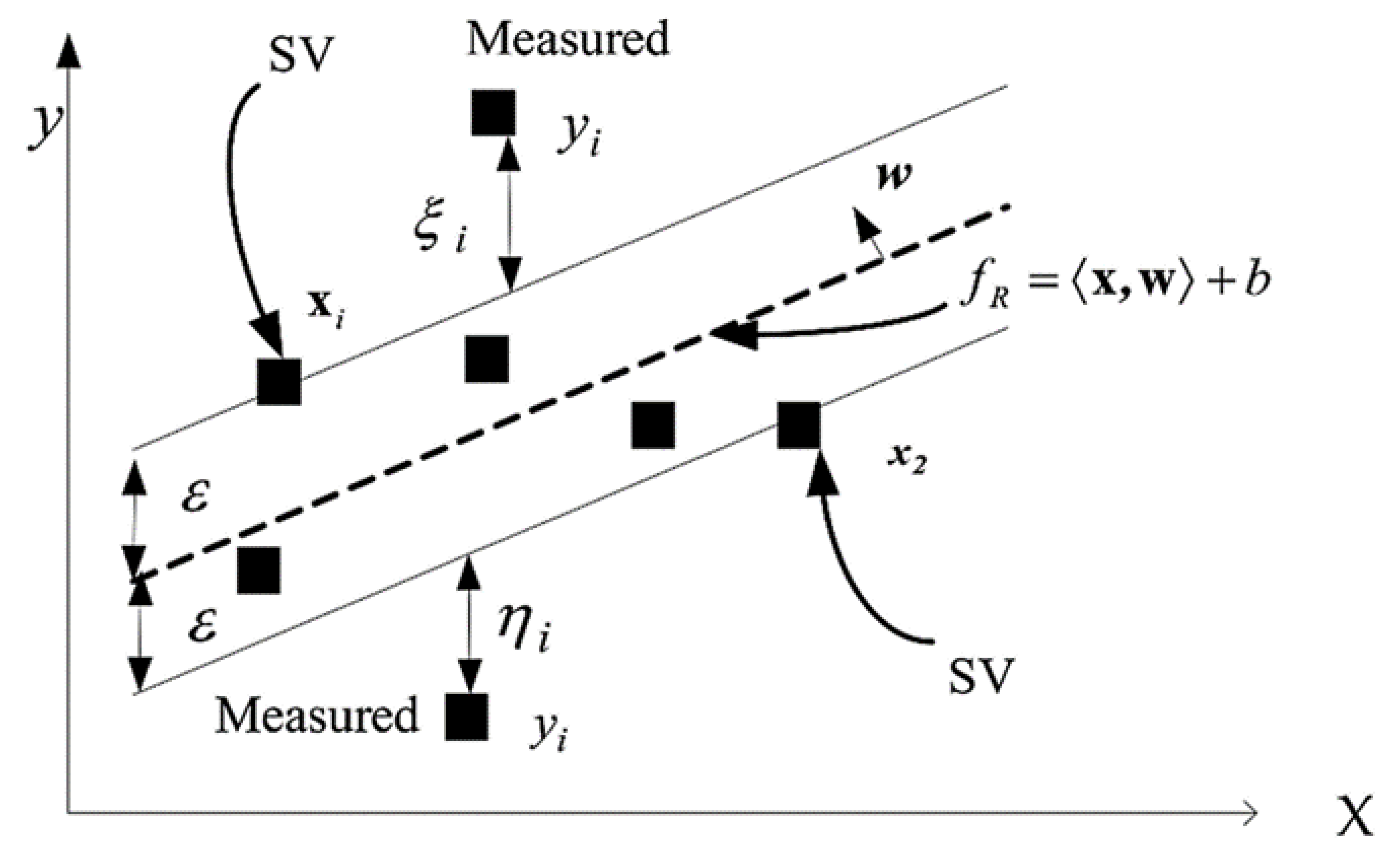


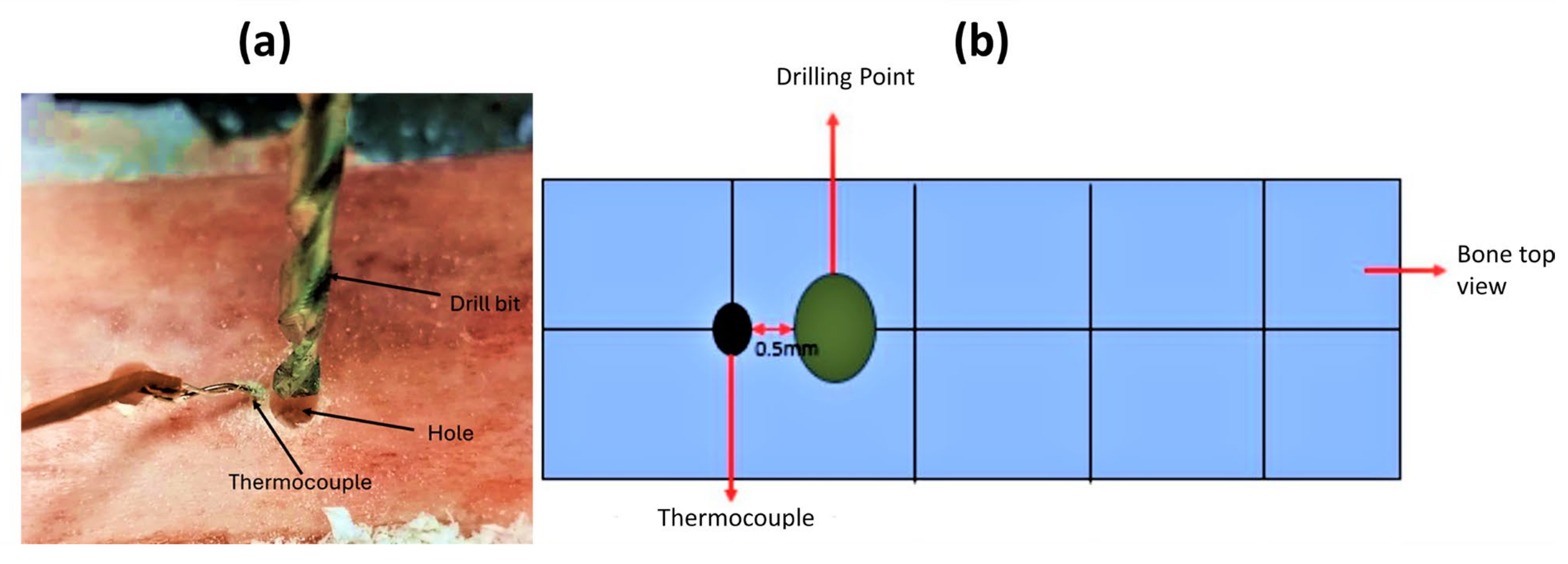
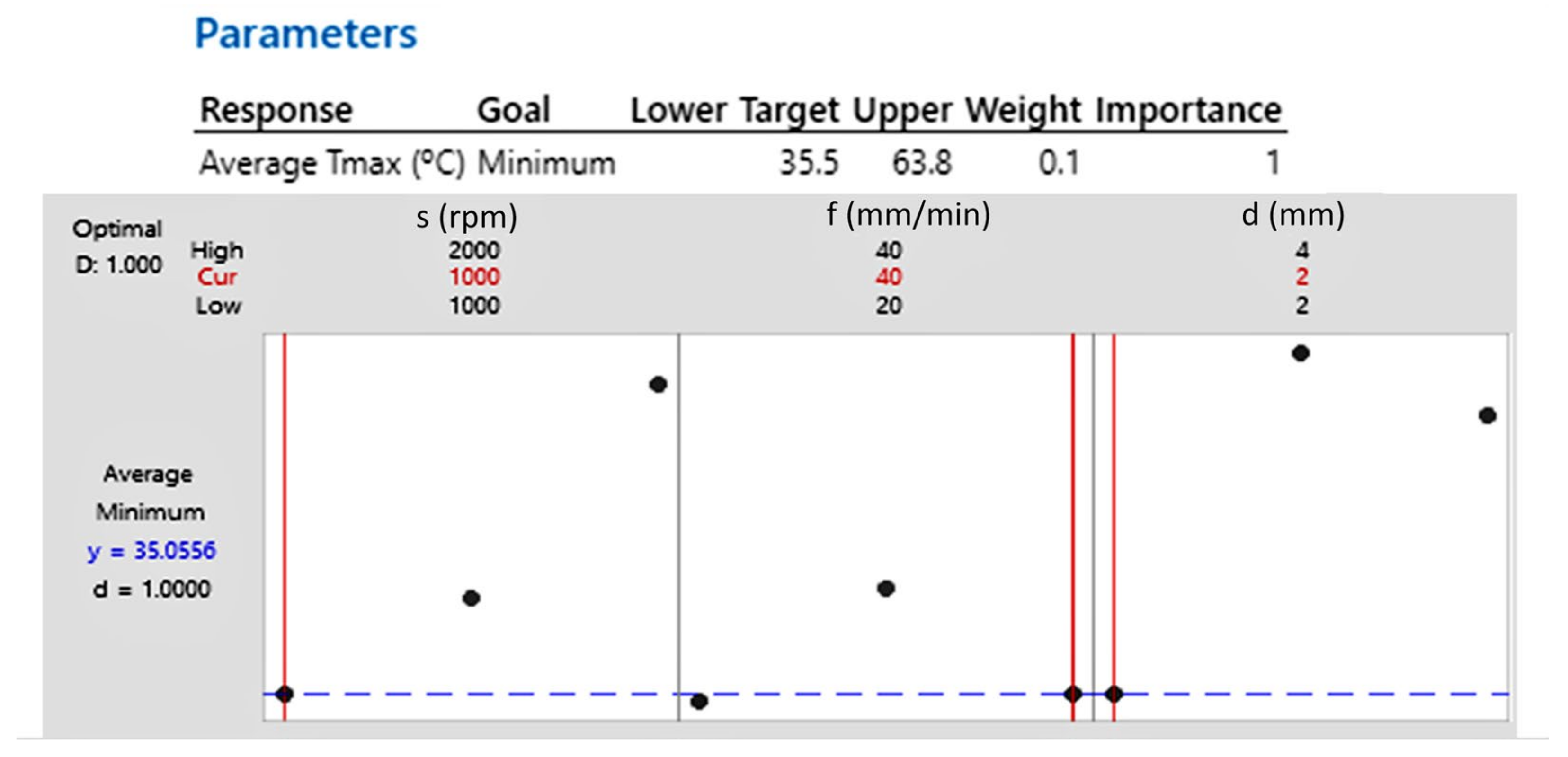

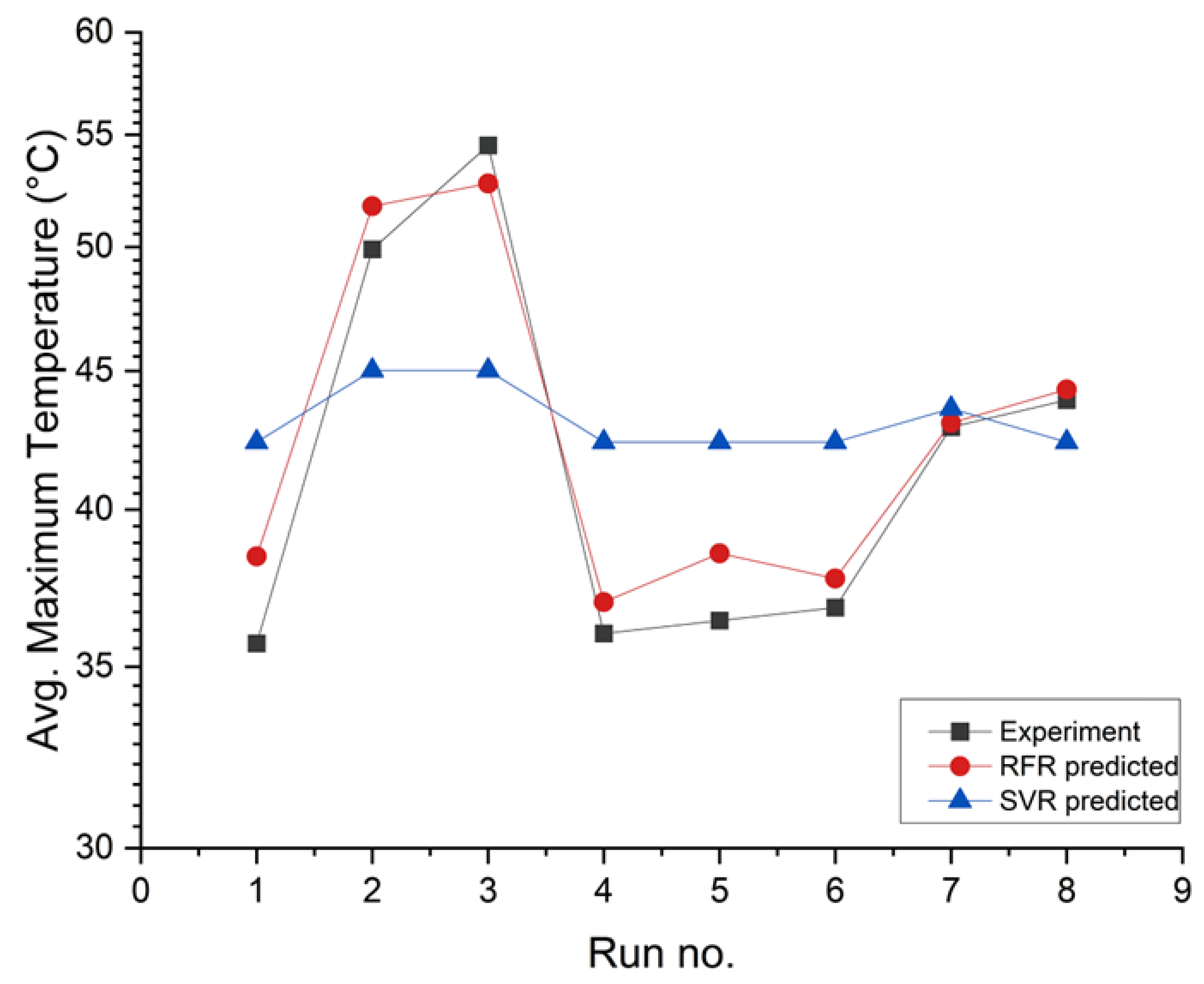
| Machine: Sainsmart Genmitsu 3018-PROVer CNC (Sainsmart, Las Vegas, NV, USA) | |||
|---|---|---|---|
| Cutting Tool: HSS 118° | |||
| Process parameter | Spindle speed (rpm) | Feed rate (mm/min) | Drill bit diameter (mm) |
| 1000 | 20 | 2 | |
| 1500 | 30 | 3 | |
| 2000 | 40 | 4 | |
| Spindle Speed (rpm) | Feed Rate (mm/min) | Drill Bit Diameter (mm) | Average Tmax (°C) |
|---|---|---|---|
| 1000 | 20 | 4 | 36.4 |
| 1000 | 30 | 3 | 35.9 |
| 1000 | 40 | 3 | 47.7 |
| 2000 | 40 | 2 | 45.2 |
| 1000 | 40 | 4 | 43.9 |
| 1500 | 40 | 3 | 49.5 |
| 1000 | 30 | 2 | 36.8 |
| 1500 | 30 | 2 | 42.5 |
| 1000 | 20 | 2 | 36 |
| 1000 | 30 | 4 | 37.5 |
| 2000 | 30 | 3 | 54.5 |
| 2000 | 20 | 3 | 49.9 |
| 2000 | 40 | 4 | 62.5 |
| 1500 | 30 | 4 | 41.7 |
| 2000 | 20 | 2 | 44 |
| 2000 | 20 | 4 | 53.6 |
| 1500 | 20 | 2 | 37.5 |
| 2000 | 40 | 3 | 63.8 |
| 1500 | 20 | 3 | 43.4 |
| 1500 | 40 | 4 | 48.6 |
| 1500 | 40 | 2 | 37.5 |
| 1000 | 40 | 2 | 35.5 |
| 1500 | 20 | 4 | 42.9 |
| 1500 | 30 | 3 | 46.5 |
| 1000 | 20 | 3 | 35.7 |
| 2000 | 30 | 2 | 49 |
| 2000 | 30 | 4 | 55.6 |
| Optimization | Spindle Speed (rpm) | Feed Rate (mm/min) | Dill Bit Diameter (mm) | Average Tmax (°C) |
|---|---|---|---|---|
| Initial drilling parameters | 1000 | 20 | 2 | 36 |
| Model prediction | 1000 | 40 | 2 | 35.05 |
| Experimentation | 1000 | 40 | 2 | 35.50 |
| Error percentage | - | - | - | 0.45% |
| Experimental Temperature (°C) | RFR Model Predicted Temperature (°C) | SVR Model Predicted Temperature (°C) |
|---|---|---|
| 35.7 | 38.442 | 42.360 |
| 49.9 | 51.764 | 45.013 |
| 54.5 | 52.77 | 45.013 |
| 36 | 36.976 | 42.360 |
| 36.4 | 38.538 | 42.360 |
| 36.8 | 37.726 | 42.360 |
| 42.9 | 43.051 | 43.585 |
| 43.9 | 44.299 | 42.361 |
| Bone Drilling Temperature Predictor Model Errors | ||||
|---|---|---|---|---|
| Test Errors | Training Errors | |||
| SVR model | RFR model | SVR model | RFR model | |
| R2 | 0.249 | 0.942 | 0.257 | 0.973 |
| MAPE | 0.125 | 0.033 | 0.115 | 0.026 |
| MSE | 33.496 | 2.568 | 32.349 | 2.148 |
Disclaimer/Publisher’s Note: The statements, opinions and data contained in all publications are solely those of the individual author(s) and contributor(s) and not of MDPI and/or the editor(s). MDPI and/or the editor(s) disclaim responsibility for any injury to people or property resulting from any ideas, methods, instructions or products referred to in the content. |
© 2024 by the authors. Licensee MDPI, Basel, Switzerland. This article is an open access article distributed under the terms and conditions of the Creative Commons Attribution (CC BY) license (https://creativecommons.org/licenses/by/4.0/).
Share and Cite
Islam, M.A.; Kamarrudin, N.S.B.; Ijaz, M.F.; Daud, R.; Basaruddin, K.S.; Abdullah, A.N.; Takemura, H. Supervised Machine Learning to Predict Drilling Temperature of Bone. Appl. Sci. 2024, 14, 8001. https://doi.org/10.3390/app14178001
Islam MA, Kamarrudin NSB, Ijaz MF, Daud R, Basaruddin KS, Abdullah AN, Takemura H. Supervised Machine Learning to Predict Drilling Temperature of Bone. Applied Sciences. 2024; 14(17):8001. https://doi.org/10.3390/app14178001
Chicago/Turabian StyleIslam, Md Ashequl, Nur Saifullah Bin Kamarrudin, Muhammad Farzik Ijaz, Ruslizam Daud, Khairul Salleh Basaruddin, Abdulnasser Nabil Abdullah, and Hiroshi Takemura. 2024. "Supervised Machine Learning to Predict Drilling Temperature of Bone" Applied Sciences 14, no. 17: 8001. https://doi.org/10.3390/app14178001







